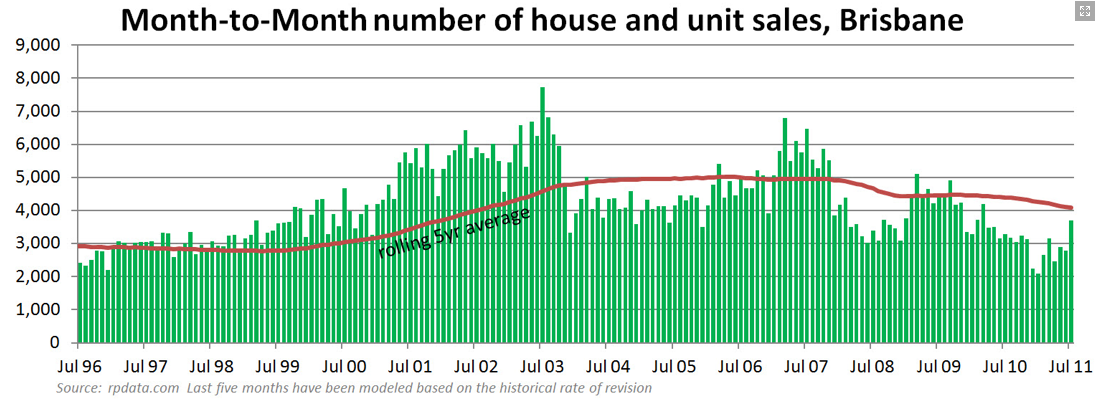The latest RPData video came out last week with an overview of the market using their August data. If you don’t want to watch the entire 17 minutes but are interested in a particular market Sydney is @3:50, Melbourne @5:35, Brisbane @7:42, Adelaide @9:40, Perth @10:55 , Darwin @12:25, Canberra @13:20 and Hobart @14:30.
The are couple of things worth mentioning from the video. Obviously the stock on market graph @3:28 is pretty scary, although that was covered yesterday. Tim’s discussion of Melbourne isn’t much better and we will be hearing much more about that from the Unconventional Economist next week. Perth is also looking awful.
The other thing that I noted was the discussion @8:58 of the large pickup in sales volumes for Brisbane in July. As I stated back then:
I am actually expecting to see a bit of an uptick in median values in July as people bring forward their property transactions to beat the rise in stamp duty from August 1st. However there is not much movement in the latest auction rates data to support that theory, even so I am fairly sure that is what we will end up seeing.
However, after July 31 I would expect to see another slump after the mini-boom of July and I certainly cannot see anything in either the sales volumes or credit issuance trends in Queensland to support rising prices.
And then early last month I stated:
The most interesting thing that I take away is that Queensland managed to re-stimulated the market with the incentive of a small time limited tax break. This is a clear demonstration that it is still very easy to stimulated demand in the housing market no matter how crazy you think the participants are in accepting such a deal. This small market intervention by the Queensland government may require a re-assessment by anyone who thought that stimulus would not be as effective a second time around.
We estimate that Queensland sales volumes jumped by 33% over the month of July as owner occupier buyers surged into the market to avoid the additional stamp duty expense.
The surge in buyer numbers suggests that buyer confidence may not be as low as many thought. A saving of around $6,500 is a substantial incentive particularly when coupled with the First Home Owners Grant of $7,000. However the surge came at a time when the threat of higher interest rates was still quite real; it was only mid July when Bill Evans broke ranks and predicted rates were set for a fall (and at the time his comments weren’t widely accepted!).
I obviously agree with Tim as I said nearly the exact same thing 4 weeks early, however it is my understanding that the stamp duty changes do not apply to first home buyers and there is also the effects of the building boost to take into account. With that in mind, I think we have seen is an uptick in sales driven by non-first home buyers of existing properties. That being that case the incentive was in fact as small as $6500. Again, possibly time to re-assess your thoughts on the ability of the government to re-stimulate the housing market. Not that I am saying it will.
There does, however, seem to be a bit of a misstep in Tim’s logic later in the same blog post when he states:
The magnitude of declines across the Brisbane housing market has eased. In fact, the latest RP Data-Rismark Home Value Indices for Brisbane showed the quarterly change over the three months to August was the second highest of any capital city. The result was still negative, at -1.3%, however it was a substantial improvement from the falls being recorded earlier in the year, the worst of which was seen over the March quarter when values were down 3.0%.
Umm….. As discussed, the one-off effect of legislative changes caused a surge in sales in July, I suspect this probably pulled some sentiment forward into August as well. I think it would probably be prudent to wait until September to get a better feel of how the market is actually travelling before making statements about “substantial improvements” in the market. At the least some trend adjustment to the data would seem appropriate.
